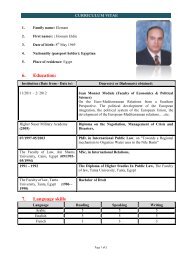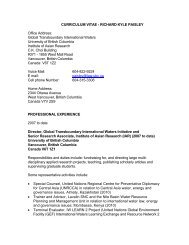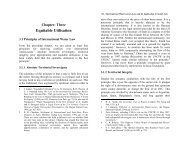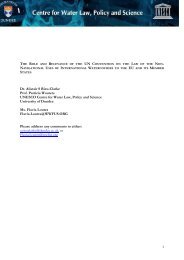Upreti, Trilochan, International Watercourses Law and Its Application ...
Upreti, Trilochan, International Watercourses Law and Its Application ...
Upreti, Trilochan, International Watercourses Law and Its Application ...
You also want an ePaper? Increase the reach of your titles
YUMPU automatically turns print PDFs into web optimized ePapers that Google loves.
Equitable Utilisation / 153 154 / <strong>International</strong> <strong>Watercourses</strong> <strong>Law</strong> <strong>and</strong> <strong>Its</strong> <strong>Application</strong> in South AsiaThe 1991 Madrid Protocol to the Antarctica Treaty, signed bytwenty-four states, provides that the environmental or scientificinterest in the continent represents a form of common heritageequity, in which conservation is paramount. 148 The pact departsfrom the mercantile model of common heritage equity,assuming the role of a trustee pledged to hold this asset in trustfor the benefit of human kind. This concept is taken from aprotocol to the 1959 Antarctica Treaty that banned nuclear <strong>and</strong>military activity, suspended competing claims by sevensouthern hemisphere states <strong>and</strong> established rules for scientificresearch. 149 This Protocol seeks protection of the environmentas a 'fundamental consideration' in planning <strong>and</strong> conducting allactivities on the continent, <strong>and</strong> bans all mineral exploitation forat least fifty years, as such activities would severely damage thesanctity of the Antarctic environment. 150The right of the yet to be born is not an idea of recent origin ininternational law. Such feelings have emerged <strong>and</strong> beendeveloped in the international arena for over a hundred years.The idea was evident in the Bering Sea Fur Arbitration wherethe USA had argued that it was conserving the seals in thecommon interest of mankind. 151 French has argued since thenthat the notion of protecting the environment for present <strong>and</strong>future generations has appeared occasionally in internationalenvironmental law, for example the <strong>International</strong> Conventionfor the Regulating of Whaling 1946, 152 the 1968 AfricanConvention on the Conservation of Nature <strong>and</strong> NaturalResources, 153 <strong>and</strong> the 1972 World Heritage Convention. 154Each instrument stipulates a requirement to protect148 Supra note 69, p. 593.149 Ibid.150 Ibid. Also see 29-30 ILM (1991), pp. 1462-1486.151 Supra note 67, p. 10478.152 161 UNTS, 1946, p. 72.153 1001 UNTS, 1968, p.4.154 11 ILM 1973, p. 1358.environmental resources for present <strong>and</strong> future generations. 155Since then, the notion has become an almost indispensable partof major environmental instruments. 156 For example, thepreamble of the 1998 Statute of the <strong>International</strong> CriminalCourt states,“an international criminal court is required for the sakeof present <strong>and</strong> future generations.” 157The goal of the ICC is to protect present <strong>and</strong> future generationfrom cruel <strong>and</strong> inhuman brutality.3.8 Equity: an Integral Aspect of SustainableDevelopmentThe Brundtl<strong>and</strong> Report is commonly viewed as the point atwhich sustainable development became a broad global policyobjective. Equity has been a milestone in the preservation <strong>and</strong>protection of the environment by strengthening the idea ofsustainable development. The main achievement of the UnitedNations Conference on Environment <strong>and</strong> Development(UNCED) was the adoption of the equitable principle at the155 Ibid.156 a. the World Charter for Nature 1982 in its fifth paragraph provides '… man must acquire knowledge … which ensures the preservationof species <strong>and</strong> eco-systems for the benefit of present <strong>and</strong> futuregenerations'.b. the Madrid protocol on Antarctica, 1991 provides in the seventhpreambular paragraph: "convinced that the development of acomprehensive regime for the protection of the Antarcticenvironment <strong>and</strong> dependent <strong>and</strong> associated systems is in the interestof mankind as a whole …".c. the 1972 Stockholm Declaration in principle 1 states that verynotion.d. whilst in the Rio Declaration in principles 3 provides, "present <strong>and</strong>future generations have both developmental <strong>and</strong> environmentalneeds; apart from this, every document adopted at Rio, bear thisnotion explicitly . Birnie <strong>and</strong> Boyle, pp. 11, 16 & 4.157 37 ILM (1998), p. 999.












